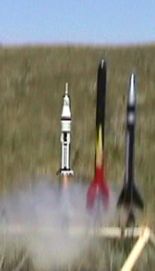| Construction Rating: | starstarstarstarstar_border |
| Flight Rating: | starstarstarstarstar |
| Overall Rating: | starstarstarstarstar_border |

Brief:
This is a smaller vintage Saturn 1B than the Estes version and has vacu-formed wraps. It clusters two 18mm motors and
separates into an upper and lower section for recovery under two parachutes.
Construction:
The instructions are intricate, clear, and excellent.
The original owner had done minimal work, so I was able to complete nearly the entire kit.
It has a huge number of parts, which starts with the fin can. There are 21 parts here. The fin can body tube is paper covered with a vacu-formed wrap. There are 8 two-piece vacu-formed fins. It all fits together nicely and is very sturdy.
Next the upper main body. It's a 65mm ID paper body tube with two vacu-formed wraps, two hardwood "utility tunnels" and launch lug with standoff. It's glued onto the forward centering ring/bulkhead for the tanks and an additional centering ring further forward on an inner parachute tube.
The LEM (long upper shroud) is next. The inner core LEM body that extends up to the Apollo capsule is 38mm. There's a standard paper shoulder with paper cardstock centering rings. The shroud is paper so it has a seam and even with copious filling and finishing, it doesn't look perfectly round. Balsa would have been a better choice here.
 The tower and capsule are precision molded. The pieces assemble quickly. The tower skirt and
nozzles are styrene, as are the nose cone and capsule. The escape tank is a thin-wall 3/16" launch lug. When
completed it's very sturdy.
The tower and capsule are precision molded. The pieces assemble quickly. The tower skirt and
nozzles are styrene, as are the nose cone and capsule. The escape tank is a thin-wall 3/16" launch lug. When
completed it's very sturdy.
The main body is a 28mm ID parachute tube around which the eight external tank BT-20s are glued. The tanks were primed with high-build automotive primer twice and sanded to eliminate the very small spirals. They were painted white and black before assembly.
The two motor mounts have standard 18mm metal clips, sleeves that slip over them to retain them, and thick die cut card stock centering rings fore and aft. The model has a nice looking friction-fit assembly of eight vacu-formed engine bells for display.
There are four vacu-formed antenna panels for the area just aft of the upper main body.

Finishing:
The fin can (including forward shroud) must be slid over the entire length of the finished, painted main body. Since
it's necessarily a tight, precision fit, paint touch up is to be expected after the fin can is glued into place. After
the SM is painted white, a sharp looking self-adhesive mirror-finish silver panel is applied followed by the RCS
nozzles.
The original waterslide decals were badly yellowed and so fragile they disintegrated, so new ones were made using a JimZ download (scaled-down Estes version with the blue background deleted) as a template and Testor's inkjet decal material.
Construction Rating: 4 out of 5
Flight:
The two 18mm motor mounts are recessed 22mm to enhance stability.
Recommended motors are two C6-5s or two B6-4s. It has flown successfully on both. It may one day fly on two D13-7 reloads. See a video of a C6-5 flight.
 The outside diameter of a contemporary thin-walled 29mm motor mount tube might be a perfect
fit for the main inner body tube, which I know will give some of you evil thoughts.
The outside diameter of a contemporary thin-walled 29mm motor mount tube might be a perfect
fit for the main inner body tube, which I know will give some of you evil thoughts.
Recovery:
The shock cord mount in the main body is a step up from the tri-fold paper and is comprised of a half piece of body
tube that's glued in with the shock cord.
The LEM separates from the main body and has rigging to keep it horizontal so the tower doesn't hit the ground first. It came with a 16" thin mylar parachute but would happily land on anything from 12" to 18" depending on size and softness of launch area. The main body has a 24" chute.
Flight Rating: 5 out of 5
Summary:
This is my favorite rocket, and I have quite a fleet. It's so rare that most old guys don't even recognize it. It's a
gorgeous display in my office. It flies great. It's a builder's kit with lots of pieces, but it's pretty easy to build.
Overall Rating: 4 out of 5
Sponsored Ads
 |
 |











